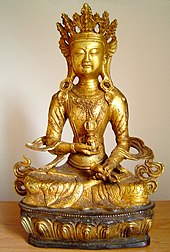Vajra
'Thunderbolt', IAST: Vajra) is a legendary and ritualistic tool, symbolizing the properties of a diamond (indestructibility) and a thunderbolt (irresistible force).
It is used symbolically by the dharmic traditions of Hinduism, Buddhism, and Jainism, often to represent firmness of spirit and spiritual power.
[4] According to Asko Parpola, the Sanskrit vajra- (वज्र-) and its Avestan cognate vazra- are possibly ultimately derived from the Proto-Indo-European root *weg'- which means "to be(come) powerful".
The associated story describes Indra using the vajra, which he held in his hand, to slay the asura Vritra, who took the form of a serpent.
[8] In the context of Rigvedic weaponry, the word vájra appears to have been used for the sling as a weapon, but also for extremely effective sling projectiles specially crafted from lead corresponding to cast lead projectiles as they were in widespread use in the cultural areas of the Middle East and the ancient world, especially in classical antiquity.
[12] Indra then brought together all the waters of the holy rivers to Naimisha Forest,[12] thereby allowing the sage to have his wish fulfilled without a further loss of time.
Another version of the story exists where Dadhichi was asked to safeguard the weapons of the devas as they were unable to match the arcane arts being employed by the asura to obtain them.
Dadhichi is said to have kept at the task for a very long time and finally tiring of the job, he is said to have dissolved the weapons in sacred water which he drank.
However, Dadhichi, realising that his bones were the only way by which the deva could defeat the asura willingly gave his life in a pit of mystical flames he summoned with the power of his austerities.
[14] According to the Ramayana, as a child, Hanuman grew to enormous proportions, and attempted to swallow the sun, regarding it to be a ripe fruit.
When Hanuman attempted to seize his mount, Indra retaliated by striking the former's chin with the vajra, who descended upon the earth.
[15] The child's spiritual father and god of the wind, Vayu, caught him before he crashed upon the ground, and withdrew to a cave.
In the tantric traditions of Buddhism, the vajra is a symbol for the nature of reality, or sunyata, indicating endless creativity, potency, and skillful activity.
The vajra is representative of upaya (skilful means) whereas its companion tool, the bell which is a female symbol, denotes prajna (wisdom).
[19] Some deities are shown holding each the vajra and bell in separate hands, symbolizing the union of the forces of compassion and wisdom, respectively.
These are mythological half-fish, half-crocodile creatures[4] made up of two or more animals, often representing the union of opposites, (or a harmonisation of qualities that transcend our usual experience).
The sound made by the bells is regarded as very auspicious and is believed to drive out evil spirits from where the ritual is being performed.
During meditation ringing the bell represents the sound of Buddha teaching the dharma and symbolizes the attainment of wisdom and the understanding of emptiness.
During the chanting of the mantras the Bell and Vajra are used together in a variety of different ritualistic ways to represent the union of the male and female principles.







